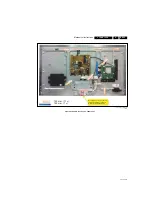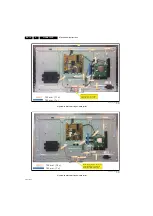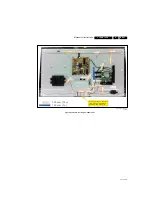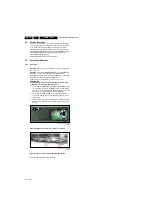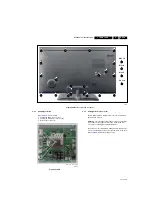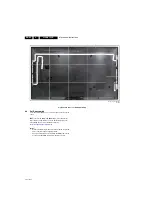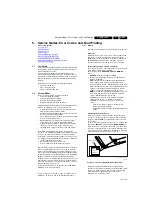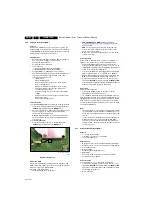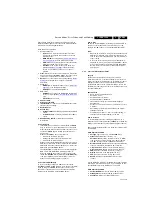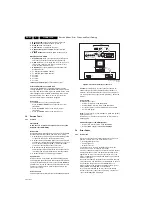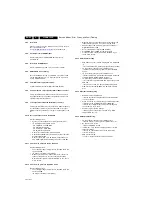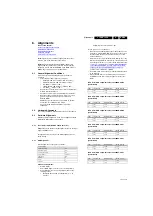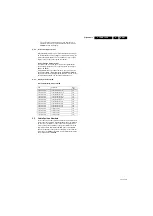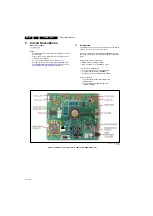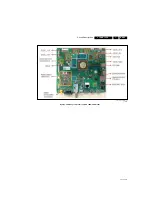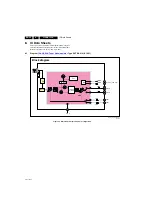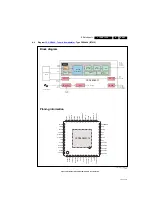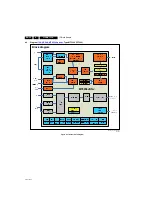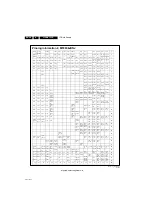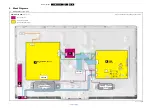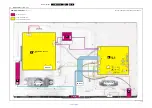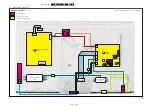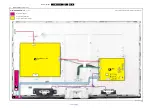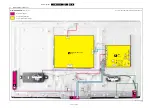
Alignments
6.
6.
Alignments
Index of this chapter:
6.1 General Alignment Conditions
6.2 Hardware Alignments
6.3 Software Alignments
6.4 Option Settings
6.5 Cable Position Numbers
Note:
Figures below can deviate slightly from the actual
situation, due to the different set executions.
General:
The Service Default Mode (SDM) and Service
Alignment Mode (SAM) are described in chapter 5. Menu
navigation is done with the CURSOR UP, DOWN, LEFT or
RIGHT keys of the remote control transmitter.
6.1
General Alignment Conditions
Perform all electrical adjustments under the following
conditions:
•
Power supply voltage (depends on region):
–
AP-NTSC: 120 V
AC
or 230 V
AC
/ 50 Hz (
10%).
–
AP-PAL-multi: 120 - 230 V
AC
/ 50 Hz (
10%).
–
EU: 230 V
AC
/ 50 Hz (
10%).
–
LATAM-NTSC: 120 - 230 V
AC
/ 50 Hz (
10%).
–
US: 120 V
AC
/ 60 Hz (
10%).
•
Connect the set to the mains via an isolation transformer
with low internal resistance.
•
Allow the set to warm up for approximately 15 minutes.
•
Measure voltages and waveforms in relation to correct
ground (e.g. measure audio signals in relation to
AUDIO_GND).
Caution:
It is not allowed to use heatsinks as ground.
•
Test probe: Ri > 10 Mohm, Ci < 20 pF.
•
Use an isolated trimmer/screwdriver to perform
alignments.
6.2
Hardware Alignments
There are no hardware alignments foreseen for this chassis.
6.3
Software Alignments
With the software alignments of the Service Alignment Mode
(SAM) the RGB settings can be aligned.
6.3.1
Tuner Adjustment (RF AGC Take Over Point)
Purpose:
To keep the tuner output signal constant as the input
signal amplitude varies.
No alignment is necessary, as the AGC alignment is done
automatically.
6.3.2
RGB Alignment
Before alignment, set the picture as follows:
White Tone Alignment:
•
Activate SAM.
•
Select “RGB Align.“ and choose a color temperature.
•
Use a 100% white screen as input signal and set the
following values:
–
“Red BL Offset” and “Green BL Offset” to “7” (if
present).
–
All “White point” values initial to “127”.
In case you have a color analyzer:
•
Measure with a calibrated (phosphor- independent) color
analyzer (e.g. Minolta CA-210) in the centre of the screen.
Consequently, the measurement needs to be done in a
dark environment.
•
Adjust the correct x,y coordinates (while holding one of the
White point registers R, G or B on max. value) by means of
decreasing the value of one or two other white points to the
correct x,y coordinates (see Table
values LC320EUE-SEM1 (panel ID 402)
to
alignment values LC420EUE-SEF2 (panel ID 411)
Tolerance: dx:
0.002, dy:
0.002.
•
Repeat this step for the other color Temperatures that need
to be aligned.
•
When finished return to the SAM root menu and press
STANDBY on the RC to store the aligned values to the
NVM.
Table 6-1 White D alignment values LC320EUE-SEM1
(panel ID 402)
Table 6-2 White D alignment values LC420EUE-SEM2
(panel ID 403)
Table 6-3 White D alignment values LC470EUE-SEM2
(panel ID 404)
Table 6-4 White D alignment values LC420EUE-FEP1
(panel ID 406)
Table 6-5 White D alignment values LC470EUF-FEP1
(panel ID 407)
Table 6-6 White D alignment values LC550EUF-FEP1
(panel ID 410)
Picture Setting
Dynamic backlight
Off
Dynamic Contrast
Off
Colour Enhancement
Off
Picture Format
Unscaled
Light Sensor
Off
Brightness
50
Colour
0
Contrast
100
Value
Cool (9480 K)
Normal (8050 K)
Warm (6100 K)
x
0.280
0.292
0.319
y
0.299
0.314
0.347
Value
Cool (9710 K)
Normal (8170 K)
Warm (6150 K)
x
0.280
0.291
0.318
y
0.296
0.311
0.345
Value
Cool (9490 K)
Normal (8060 K)
Warm (6080 K)
x
0.281
0.292
0.319
y
0.297
0.311
0.345
Value
Cool (9540 K)
Normal (8060 K)
Warm (6130 K)
x
0.280
0.291
0.318
y
0.300
0.314
0.347
Value
Cool (10100 K)
Normal (8450 K)
Warm (6310 K)
x
0.277
0.288
0.315
y
0.295
0.310
0.343
Value
Cool (t.b.d. K)
Normal (t.b.d. K)
Warm (t.b.d. K)
x
t.b.d.
t.b.d.
t.b.d.
y
t.b.d.
t.b.d.
t.b.d.

